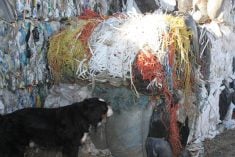When speaking with a group of rural Grade 10 students earlier this
winter, Gary Davis posed a difficult question: how do you define
sustainability?
“I really had to work on them to get an answer.”
But the answer he got wasn’t a bad one. From their collective wisdom,
the students decided that sustainability refers to something that will
go on forever.
Last week, Davis was among a group of farmers at a two-day workshop who
believe sustainability can work for them on their farms.
Read Also

Message to provincial agriculture ministers: focus on international trade
International trade stakeholders said securing markets in the face of increasing protectionism should be the key priority for Canada’s agriculture ministers.
For Davis and his family, that meant converting their grain farm near
Deloraine, Man., into pasture and hayland, and then using cattle as
forage harvesters.
He doesn’t want to own a lot of land. Instead, he wants to improve the
soil, increase the land’s productivity, and earn a living by tapping
consumer demand for things like grass-finished beef.
At the same time, he and his family have found a quality of life that
they enjoy. And they know of other farm families in their area who have
re-examined how they farm and have also made changes to become more
sustainable.
Robert Stevenson, a Kenton, Man., producer, is taking sustainable
agriculture in another direction by testing the potential of
pesticide-free production, or PFP.
The goal is to use less pesticides, which could save money, benefit the
environment, and at least partially address public concerns about
pesticides. Stevenson presented research that suggests there might also
be a small premium for PFP crops.
“A lot of consumers are concerned about pesticide use and don’t want
excessive pesticide sprayed on their food,” Stevenson said.
The idea is to grow a crop without the use of pesticides from the time
the crop emerges until it is marketed. Last year, 40 farmers produced
PFP crops on 55 fields in Manitoba.
Bob Mazer of Brandon added another twist to the discussion – that
intensification is better than expansion.
He is president and chief executive office of the R.G. Mazer Group,
which farms 6,000 acres in Manitoba and is part owner of several
implement dealerships.
His goal is to make more revenue per acre, either by diversifying or
adding value to what is produced.
While that might include growing a higher-value crop like potatoes or
adding an intensive livestock operation, he said it could also mean
improving a pasture so that it carries more cattle, which avoids the
need to buy more land to expand.
When talking about the environment, he emphasized water, and the need
for a water management strategy in Manitoba.
“The future of sustainable agriculture lies with how we deal with this
precious commodity.”
He also cautioned against putting too much hope on government
subsidies, because Canada’s treasury is not as big as those of the
United States and the European Union.
Joe Federowich farms 6,000 acres with his family near Dauphin, Man.
Hemp, sea buckthorn and livestock are only a sample of his
diversification efforts.
He took a step back into the past before talking about his thoughts on
where the future might be for sustainable farming.
In the 1970s, he believed his position as a farmer was secure because
he was growing crops to feed an increasing world population. The crops
were planted, harvested and hauled to the elevator. The marketing was
simple.
A lot has changed since then, Federowich said, pointing out
opportunities to develop niche markets and to find alternative uses for
crops that are no longer just a food. Their fibres and oils also lend
themselves to a variety of industrial uses.
“Our job has really shifted.”
Part of the job now is to become more market savvy and to find ways to
add as much value to each farm commodity as possible, he said.














